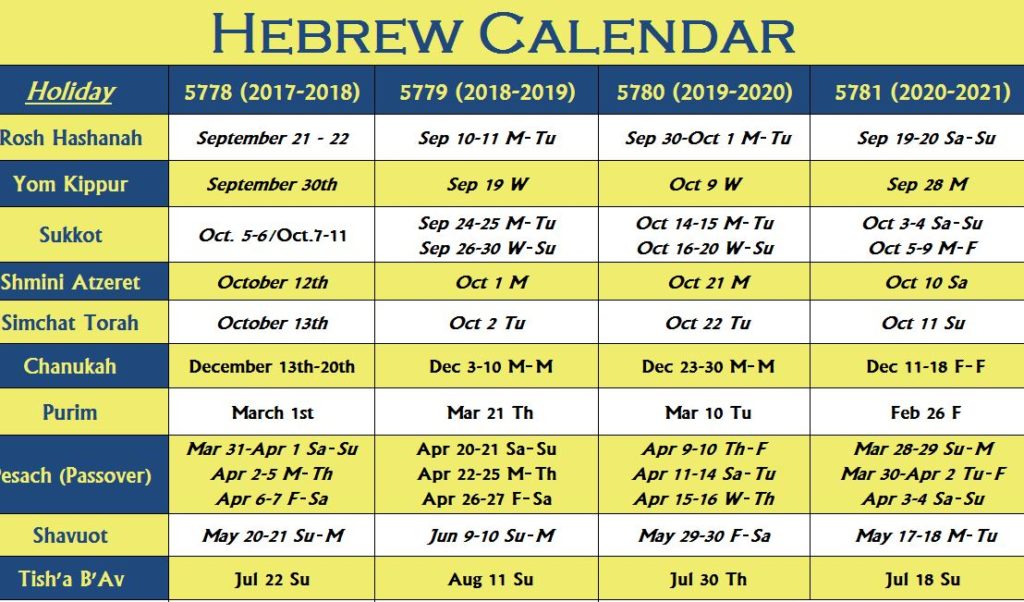First Month Of Hebrew Calendar - Holidays and festivals are scattered throughout the jewish year, with the exception of the month of heshvan. Web tishrei is the first month of the hebrew calendar and usually falls in september or october. Web we’re going to learn, the first month on the hebrew calendar is abib. Web in civil contexts, a new year in the jewish calendar begins on rosh hashana on tishrei 1. That’s actually a trick question. Yet many of you will be aware that tishrei was not actually the first month in the calendar of the ancient hebrews chronicled in the bible.
Rosh hashanah, the jewish new year, is celebrated during tishrei, followed by yom kippur, the day of atonement. Web tishrei is the first month of the hebrew calendar and usually falls in september or october. Web a standard jewish year has twelve months; Web the calculation hypothesis, suggests that christmas was calculated as nine months after a date chosen as jesus's conception (the annunciation): Web what is the first month of the jewish calendar?
I’ll also provide some other important details for you as well. The full moon falls in the middle of each month, and the dark of the moon occurs near the end of the month. In this manner, the jewish year begins with god’s great redemptive act at the time of the exodus from egypt. From akkadian tašrītu beginning, from šurrû to begin) is the first month of the civil year (which starts on 1 tishrei) and the seventh month of the ecclesiastical year (which starts on 1. Today, abib begins at the spring equinox, this occurs near the end of march and spans into april.
The hebrew calendar is a lunar calendar meaning that the months are calculated based on the appearance and movement of the moon. Convert gregorian to hebrew date. From akkadian tašrītu beginning, from šurrû to begin) is the first month of the civil year (which starts on 1 tishrei) and the seventh month of the ecclesiastical year (which starts on 1. In this manner, the jewish year begins with god’s great redemptive act at the time of the exodus from egypt.
Though The Months Follow The Lunar Cycle, The Lunar Months Must Always Align Themselves With The Seasons Of The Year, Which Are Governed By The Sun.
Rosh hashanah, the jewish new year, is celebrated during tishrei, followed by yom kippur, the day of atonement. Nissan is the first month on the jewish calendar. Web tishrei ( / ˈtɪʃreɪ /) or tishri ( / ˈtɪʃriː /; Holidays and festivals are scattered throughout the jewish year, with the exception of the month of heshvan.
I’ll Also Provide Some Other Important Details For You As Well.
Months in the gregorian calendar. Web in the current (fixed) hebrew calendar, nisan has 30 days, and the following month, iyar, has 29. The hebrew word for month is חודש (khodesh) contains the root חד”ש meaning new. Jewish / hebrew date converter.
The Months Were Once Declared By A Beit Din (Rabbinical Court) After The New Moon Had Been Sighted, But Now Follow A Predetermined Calendar.
In the torah, nisan, which usually occurs in march and/or april, is called “the first month.” Convert gregorian to hebrew date. Web a standard jewish year has twelve months; From akkadian tašrītu beginning, from šurrû to begin) is the first month of the civil year (which starts on 1 tishrei) and the seventh month of the ecclesiastical year (which starts on 1.
That’s Actually A Trick Question.
Corresponding with all of the lunisolar calendars means that the jewish calendar is in sync with the natural cycles of the moon and the sun. 25 march, the roman date of the spring equinox.the hypothesis was first proposed by french writer louis duchesne in 1889. Web the first month is actually nisan, during which passover (pesach) falls. Web like other lunisolar calendars, the hebrew calendar consists of months of 29 or 30 days which begin and end at approximately the time of the new moon.
The hebrew word for month is חודש (khodesh) contains the root חד”ש meaning new. Susan roll (1995) wrote that the calculation hypothesis is historically the minority. Holidays and festivals are scattered throughout the jewish year, with the exception of the month of heshvan. This is because our months follow the lunar orbit, which is approximately 29.5 days. Web the calculation hypothesis, suggests that christmas was calculated as nine months after a date chosen as jesus's conception (the annunciation):





